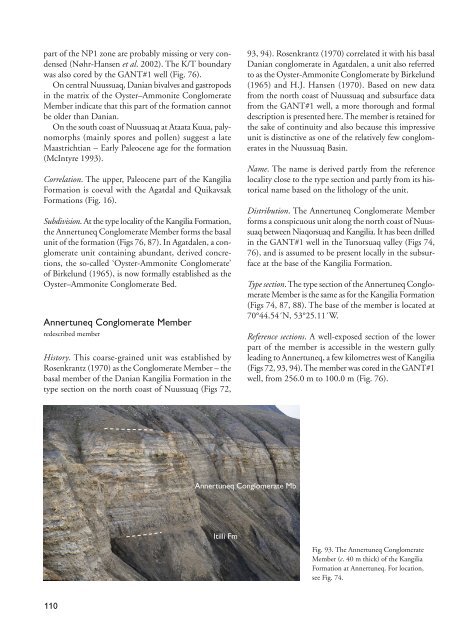Geological Survey of Denmark and Greenland Bulletin 19 ... - Geus
Geological Survey of Denmark and Greenland Bulletin 19 ... - Geus
Geological Survey of Denmark and Greenland Bulletin 19 ... - Geus
Create successful ePaper yourself
Turn your PDF publications into a flip-book with our unique Google optimized e-Paper software.
part <strong>of</strong> the NP1 zone are probably missing or very condensed<br />
(Nøhr-Hansen et al. 2002). The K/T boundary<br />
was also cored by the GANT#1 well (Fig. 76).<br />
On central Nuussuaq, Danian bivalves <strong>and</strong> gastropods<br />
in the matrix <strong>of</strong> the Oyster–Ammonite Conglomerate<br />
Member indicate that this part <strong>of</strong> the formation cannot<br />
be older than Danian.<br />
On the south coast <strong>of</strong> Nuussuaq at Ataata Kuua, palynomorphs<br />
(mainly spores <strong>and</strong> pollen) suggest a late<br />
Maastrichtian – Early Paleocene age for the formation<br />
(McIntyre <strong>19</strong>93).<br />
Correlation. The upper, Paleocene part <strong>of</strong> the Kangilia<br />
Formation is coeval with the Agatdal <strong>and</strong> Quikavsak<br />
Formations (Fig. 16).<br />
Subdivision. At the type locality <strong>of</strong> the Kangilia Formation,<br />
the Annertuneq Conglomerate Member forms the basal<br />
unit <strong>of</strong> the formation (Figs 76, 87). In Agatdalen, a conglomerate<br />
unit containing abundant, derived concretions,<br />
the so-called ‘Oyster-Ammonite Conglomerate’<br />
<strong>of</strong> Birkelund (<strong>19</strong>65), is now formally established as the<br />
Oyster–Ammonite Conglomerate Bed.<br />
Annertuneq Conglomerate Member<br />
redescribed member<br />
History. This coarse-grained unit was established by<br />
Rosenkrantz (<strong>19</strong>70) as the Conglomerate Member – the<br />
basal member <strong>of</strong> the Danian Kangilia Formation in the<br />
type section on the north coast <strong>of</strong> Nuussuaq (Figs 72,<br />
93, 94). Rosenkrantz (<strong>19</strong>70) correlated it with his basal<br />
Danian conglomerate in Agatdalen, a unit also referred<br />
to as the Oyster-Ammonite Conglomerate by Birkelund<br />
(<strong>19</strong>65) <strong>and</strong> H.J. Hansen (<strong>19</strong>70). Based on new data<br />
from the north coast <strong>of</strong> Nuussuaq <strong>and</strong> subsurface data<br />
from the GANT#1 well, a more thorough <strong>and</strong> formal<br />
description is presented here. The member is retained for<br />
the sake <strong>of</strong> continuity <strong>and</strong> also because this impressive<br />
unit is distinctive as one <strong>of</strong> the relatively few conglomerates<br />
in the Nuussuaq Basin.<br />
Name. The name is derived partly from the reference<br />
locality close to the type section <strong>and</strong> partly from its historical<br />
name based on the lithology <strong>of</strong> the unit.<br />
Distribution. The Annertuneq Conglomerate Member<br />
forms a conspicuous unit along the north coast <strong>of</strong> Nuus -<br />
suaq between Niaqorsuaq <strong>and</strong> Kangilia. It has been drilled<br />
in the GANT#1 well in the Tunorsuaq valley (Figs 74,<br />
76), <strong>and</strong> is assumed to be present locally in the subsurface<br />
at the base <strong>of</strong> the Kangilia Formation.<br />
Type section. The type section <strong>of</strong> the Annertuneq Conglo -<br />
merate Member is the same as for the Kangilia Formation<br />
(Figs 74, 87, 88). The base <strong>of</strong> the member is located at<br />
70°44.54´N, 53°25.11´W.<br />
Reference sections. A well-exposed section <strong>of</strong> the lower<br />
part <strong>of</strong> the member is accessible in the western gully<br />
leading to Annertuneq, a few kilometres west <strong>of</strong> Kangilia<br />
(Figs 72, 93, 94). The member was cored in the GANT#1<br />
well, from 256.0 m to 100.0 m (Fig. 76).<br />
Annertuneq Conglomerate Mb<br />
Itilli Fm<br />
Fig. 93. The Annertuneq Conglomerate<br />
Member (c. 40 m thick) <strong>of</strong> the Kangilia<br />
Formation at Annertuneq. For location,<br />
see Fig. 74.<br />
110
















